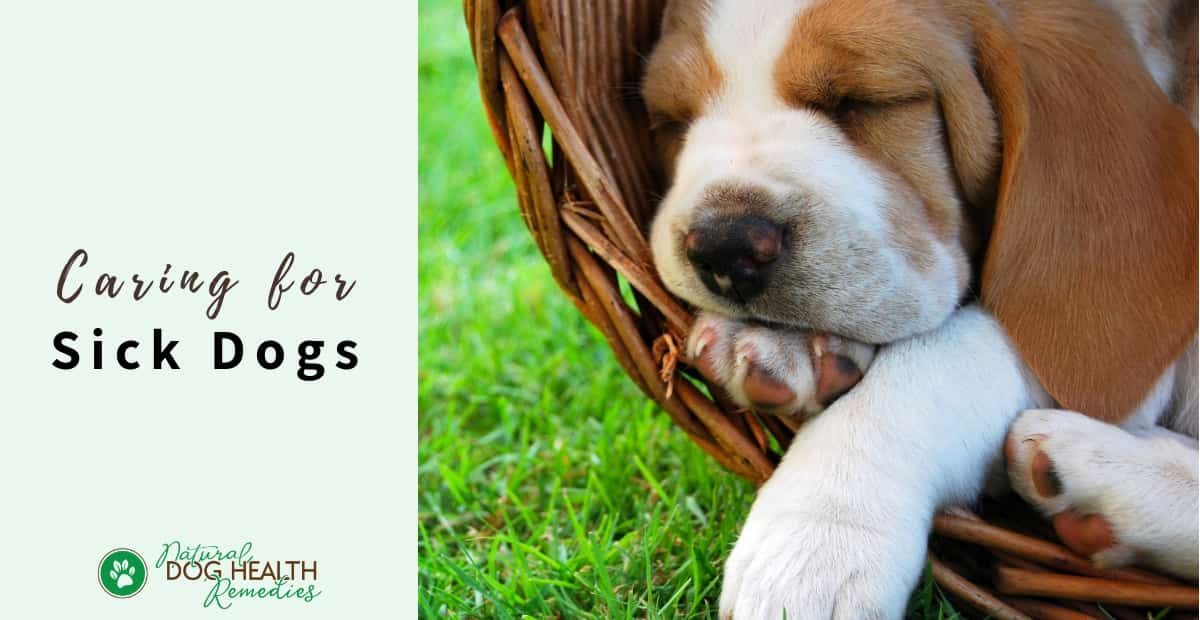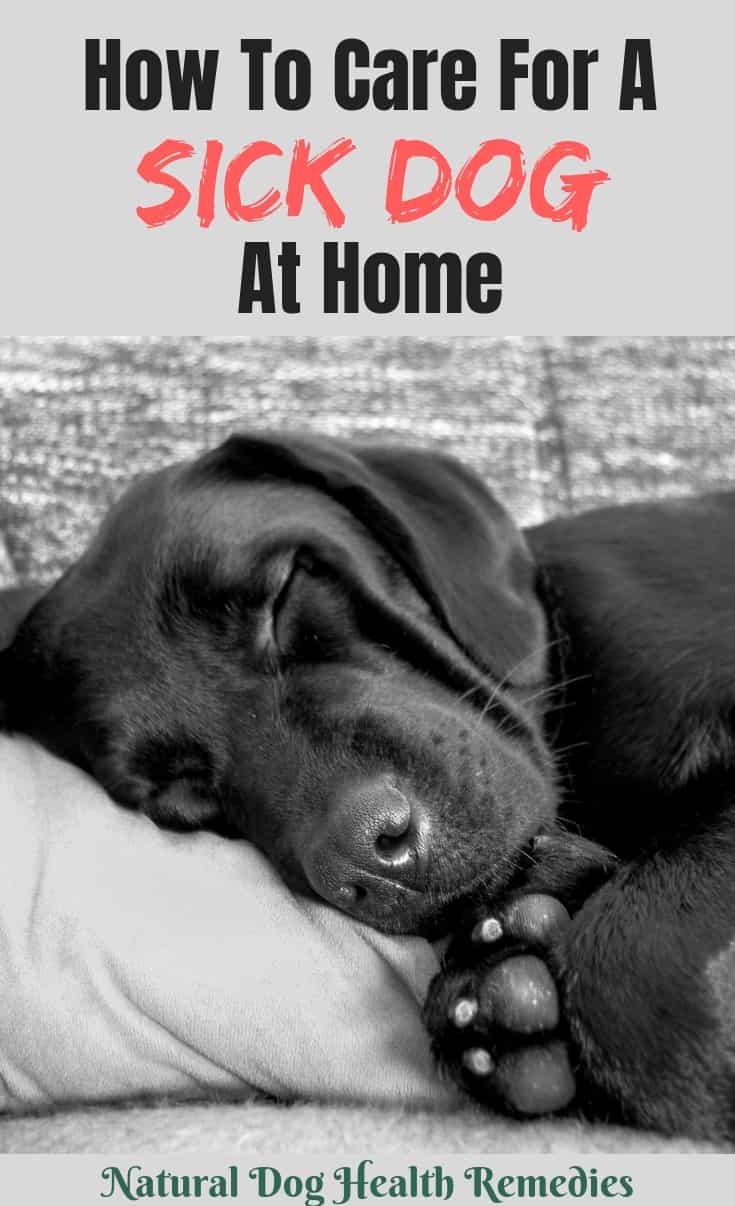Caring for Sick Dogs at Home
(FTC Disclosure: If you make a purchase via a link on this page, I may receive a small commission, at no added cost to you.)

Overview
There are a number of advantages to care for a sick dog at home. One obvious advantage is that home is familiar to the dog and definitely less stressful than staying in a hospital.
Dogs usually recover faster in their home surroundings. At home, a dog parent can pay closer attention to the needs of the sick dog, and extra meticulous cleaning can be given to the dog to keep him more comfortable and less miserable.
When you bring your dog home from the hospital, the first thing to do is to find a place in your house which is quiet, safe, cozy and warm so that your sick dog can rest comfortably. Keep the area clean and change the blankets or towels frequently. Make sure that your dog has easy access to toilet, sunlight, and fresh air.
Then it comes down to the nitty-gritty of caring for your dog. This involves:
- Feeding the Dog (What to do if the dog has no appetite?)
- Monitoring the Dog's Conditions (How to take his temperature, pulse, etc.?)
- Giving the Dog Medications (How to give pills and liquid medication to the dog?)
- Keeping the Dog Clean (How to clean the dog's eyes, nose, ears, and anus?)
Feeding a Sick Dog With No Appetite
A sick dog may need a special diet or additional supplements while recuperating, so be sure to consult your vet about the kind of foods and supplements that should be fed to your dog.
Very often, a dog who is not well (especially one who is vomiting or with a fever) chooses to fast for a day or two. If your dog does not want to eat for a few days, do not force him.
Fasting is a natural way for the body to get rid of toxic materials and wastes. Just make sure that he has sufficient water so he does not get dehydrated.
But what if your sick dog is still not eating after a few days' fasting, and he is losing weight or becoming weak?
In such a case, you need to tempt your dog into eating by giving him tasty food that has a stronger aroma, such as freshly broiled chicken or turkey on white rice. This diet is nutritious and is usually well tolerated by most dogs.
Sprinkling some culinary herbs on the food may do the trick as well. Herbs that are not only appetite-stimulating but also nutritious include peppermint, fennel, ginger, alfalfa, and dill.
You can also add a few tablespoons of bone broth such as this Only Natural Pet Human Grade Bone Broth to the food. Not only does the broth add nutrients to the diet, it's yummy, and if your dog eats dry food, the broth can soften the food a bit making it easier to eat.
Another way to coax your dog to eat is to warm up the food a bit. This works especially well for canned food. Dogs love to eat foods that have strong smells, by warming the dog food a bit, it becomes more aromatic and may just be the way to get your dog eating again.
Monitoring the Dog's Conditions
Taking care of a sick dog at home also includes monitoring and recording the dog's health conditions. This can be very helpful in tracking his progress of recovery. The records can also be invaluable information for your vet.
Your daily recording should include the following:
- Your dog's body temperature.
- Your dog's pulse. (To learn how to take a dog's temperature and pulse, click on the links above.)
- The amount of food and water intake.
- The frequency of urination and defecation. Note any abnormality in urine or stools.
- The times and amounts of medication given.
- Any change in your dog's physical or mental conditions.
Giving the Dog Medication
Many people caring for sick dogs find it hard to give medication to their dogs. Be patient, approach and speak to the dog softly. Pet the dog and calm him down before trying to give him the medicine.
Liquid Medication
- Use one hand to pull out the corner of your dog's lower lip to make a little "pocket".
- Use the other hand to tilt your dog's head back and pour the liquid into it with the other hand. You may find it easier to use a needle-less syringe to get the liquid in.
- After the medication is in, hold the dog's mouth almost closed and gently massage his throat, or blow on his nose. This can induce swallowing.
Pills and Capsules
- Using one hand, grasp around the upper jaw and insert your thumb and fingers in the gaps just behind the fangs.
- Using the other hand, hold the pill or capsule between your thumb and the first finger, and use the remaining fingers to press down the lower front teeth. This will pry the jaw open.
- Quickly insert the pill into the throat and induce swallowing as describe above.
Cleaning Sick Dogs
 Caring for sick dogs also involves keeping them clean.
Caring for sick dogs also involves keeping them clean.
Your dog can be fouled by vomiting, diarrhea, or skin discharge and you really feel that he needs a good scrubbing. However, do not bathe your dog if he has a fever, or if he is still weak and not yet fully recovered.
Even if you cannot yet give your dog a full bath, you can still keep him relatively odor-free by cleaning his body openings. Sick dogs very often have discharges from various body openings, so if you can regularly clean his openings, he will be much more comfortable and less smelly!
Cleaning the Nose
- Saturate a soft cloth with warm water and carefully clean the nose to remove any secretions that may have formed.
- If the nose has become raw and dry due to irritations from nasal discharge, apply some vitamin E oil to it once it has been cleaned. Do it 2 to 3 times a day.
Cleaning the Eyes
- Add a quarter teaspoon of sea salt to a cup of distilled warm water. Stir well.
- Saturate a soft cloth with the solution and carefully wipe the eyes to remove any secretions that may have formed.
- If the eyes are mildly irritated, put a drop of almond oil into each eye. For dry or ulcerated eyes, put a drop of cod liver oil into each eye.
These eye wipes also come in handy:
The wipes contain extracts of lavender, cucumber, witch hazel, and chamomile, and are pre-moistened with an all-natural, botanical cleansing solution.
Cleaning the Ears
Please refer to our page on Cleaning Dog Ears for steps to clean your dog's ears.
You may also want to take a look at these ear wipes:
Cleaning the Anus
If your dog has been suffering from diarrhea, his anus can get inflamed. In serious cases, the surrounding area may become irritated and even infected with bacteria. It is therefore important to keep this area clean.
- Soak a clean soft cloth in warm water and use it to sponge the anus and surrounding area gently. Do not rub since it will irritate the area further.
- After it is dry and clean, apply some calendula ointment (2 -3 times daily).
Grooming Wipes
These grooming wipes sure come in handy when caring for sick dogs takes up a lot of your time. Use a few of these wipes to quickly clean up your dog.
They contain natural ingredients (e.g. green tea leaf extract, aloe vera) and can be used to clean your dog's paws, belly and bottom.
To Recap...
It takes a lot of time and TLC to care for a sick dog at home, but the result could be rewarding!
The most important thing is to have lots of patience and love for your dog. Don't scold your dog if he made a mess of his bed or your floor. It's not his fault.
Also, exercise common sense. If, for example, your dog's condition has taken a turn for the worse, contact your vet and take your dog in for treatment immediately.





